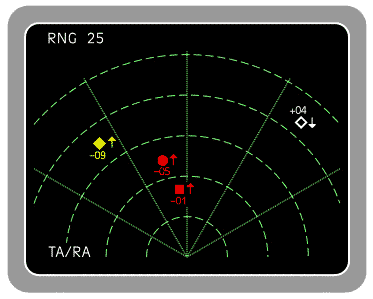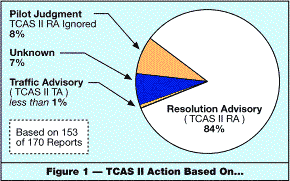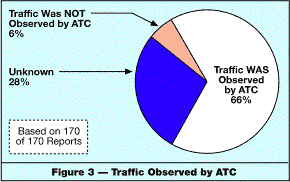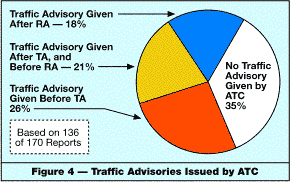![]()
Issue Number 4 : June 1993
|
|
Issue Number 4 : June 1993 |

by Vincent J. Mellone
The upsurge in TCAS incident reporting to the ASRS points to a growing controversy between flight crews and air traffic controllers. While flight crews appear to wholeheartedly endorse its use, others, specifically air traffic controllers, feel that the difficulties and teething problems of this new technology may mean that the genie is out of the bottle -- and out of control.
Since 1955, the aviation community has struggled to conceive and implement an automated airborne collision avoidance system as a backup to the air traffic control system. In 1981, Administrator J. Lynn Helms committed the resources of the Federal Aviation Administration (FAA) to the development of an airborne system by 1985. Based on 1987 congressional legislation, the FAA mandated the installation of Traffic Alert and Collision Avoidance System (TCAS II) equipment on all airliners by the end of 1993. To date, approximately 70 percent of the air carrier fleet and over 400 business aircraft are TCAS II equipped. Two thousand TCAS II aircraft have flown over 2.5 million revenue miles protected by a technology that is generating discussion and even controversy among pilots and controllers.
On July 29, 1992, at the request of the FAA's Office of Aviation Safety and the National Transportation Safety Board (NTSB), the ASRS provided an analysis of TCAS II incident reports. A random sampling of 170 TCAS II incident reports were coded and analyzed by a team of ASRS pilot and controller analysts in a Quick Response (QR) effort. An ASRS QR is an intensive, time-limited analysis of ASRS incident data. Although lacking some of the features of a more traditional research effort, QRs are capable of providing a useful and quantifiable "snapshot" of topical issues. This analysis made the overall assessment that TCAS II has definitely enhanced safety, but still has a number of technical and human-machine interface problems.
Note: As all TCAS units in current use are TCAS II systems, TCAS and TCAS II are used synonymously in this review.
There are many incident reports where flight crews assert that TCAS "saved the day." An air carrier captain writes:
And in another air carrier report...
This is the good news about TCAS, but these benefits have not been gained without some side-effects.
Most TCAS II issues reported to the ASRS encompass anomalous or erroneous operation of TCAS II equipment, TCAS-induced distraction, airborne conflicts provoked by TCAS, and non-standard use of TCAS.

Early versions of TCAS II equipment displayed some hardware and software anomalies. The reliability of TCAS equipment has improved considerably, but there continue to be some problems -- as this recent report illustrates. An air carrier flight crew departed an airport at night in mixed meteorological conditions. With high terrain very near, they experienced a very frightening situation:
Controllers obtain altitude information about traffic displayed on their radar from the Mode C function of the aircraft's radar transponder. If Mode C provides erroneous altitude information, the controller will see an incorrect altitude displayed on the scope. Should a controller note a disparity between displayed and assigned altitude, he/she will ask the flight to confirm its altitude, and may request that the flight crew reset their transponder, use a different transponder, or disable Mode C.
Like a controller, TCAS II uses Mode C information to determine vertical separation on other traffic. Should Mode C even temporarily provide erroneous altitude information, an erroneous Resolution Advisory command to climb or descend may result. Unlike a controller, TCAS II cannot query the flight crew to determine if the problem lies with malfunctioning equipment. Note the following pilot report:
The First Officer of the other aircraft (air carrier Y) writes:
Pilots frequently cite TCAS II related auditory and workload interference with normal cockpit duties, as is noted in the following report from an air carrier First Officer.
Some pilots are using TCAS displays to maintain "visual" separation. Consider the following controller report:
Many TCAS incident reports received at the ASRS allege that pilot response to erroneous TCAS commands has promoted a conflict where, initially, none existed. Consider the following near mid-air collision (NMAC) where the TCAS II RA may well have been triggered by the high climb rate of air carrier (Y).
A Controller's Dilemma
- "Air carrier (X) was inbound on the...STAR level at 10,000 feet. Under my control, air carrier (Y) departed...on the...SID, climbing to [an] assigned altitude of 9,000 feet. Approximately 14 miles SW...I issued traffic to air carrier (X) that air carrier (Y) was leveling at 9,000. Air carrier (X) responded after a few seconds that they were descending. I again told air carrier (X) to maintain 10,000 feet. Air carrier (X) responded 'OK, we've got an alert saying go down.'
"Simultaneously, air carrier (Y) was getting an alert to climb. They both followed the TCAS II [RAs] and almost collided. Later, [the pilot of air carrier (X)] ...indicated [that] his TCAS II was showing zero separation. They passed in the clouds without seeing each other. When pilots start taking evasive action, our equipment cannot update quickly enough for the controller to help. Both aircraft were issued traffic as prescribed by our handbook (merging target procedures). [Air Carrier] Company directives, I'm told, dictate that pilots must respond/follow the TCAS II alert advisories." (ACN 224796)The Captain of Air Carrier (X)
- "[We] air carrier (X) received a Traffic Advisory [TA] annunciation followed by [an] immediate RA annunciation...'Descend Crossing Descend.' We immediately pushed over following the RA to 2,000 to [a] 2,500 foot per minute descent. Intruder was showing 12 to 12:30, 800 feet below [and] climbing. I instructed the First Officer to advise ATC of [the] descent. ATC advised [the] intruder was [an] air carrier who was on a different frequency...and that he was leveling off. [The] Controller advised us to level and then climb. Both aircraft passed to each others' right on the same altitude. During the event things got confusing. [The] RA called for descent and then increased descent. ATC is calling for a level-off followed by an immediate climb." (ACN 224912)
The Controller of Air Carrier(Y) Writes...
- "[A] pilot can now disregard ATC instructions based on TCAS II alerts, even if the controller has issued traffic to that aircraft and has applied the correct separation." (ACN 224982)
In a recent congressional subcommittee hearing on TCAS II, Air Line Pilots Association (ALPA) President, J. Randolph Babbitt, testified, "Line pilots have strongly endorsed TCAS II and would emphatically resist any efforts to reduce its operational effectiveness." The National Air Traffic Controllers Association (NATCA) President, Barry Krasner, countered at the same hearing that "...TCAS [II] is highly disruptive to the air traffic control environment." The U.S. Government's General Accounting Office, in a summary of TCAS II surveys, detected that controllers have strong "negative" feelings while there is widespread pilot acceptance of TCAS II.
The pilot community, particularly ALPA, sees TCAS II as a "...last ditch, they-may-have-hit-if-something-is-not-done, piece of equipment..." that gives the pilot a precious way out if "...the ATC system has somehow unaccountably failed." Both the FAA and the airlines exhort TCAS II equipped flight crews to "...follow the RA..." when it is contrary to ATC instructions. In contrast, NATCA's Krasner ominously warns that TCAS II "...is an airborne system that works improperly and actually erodes an already precarious margin of safety in the skies." NATCA favors a moratorium on further TCAS II installations and calls for restricting alerts to TAs only. ALPA recognizes that TCAS II is not without its technical faults, but considers its enhanced safety value well worth the "growing pains." The issue appears to be settling down to two strongly different viewpoints: 1) NATCA wants the decision to separate aircraft to remain in the hands of the air traffic controller "...who has verified information to provide required separation;" 2) The pilot community wants an independent airborne collision avoidance system that leaves the decision for last-minute collision separation action in the cockpit.
The majority of TCAS II reports being received at the ASRS are favorable to the technology. According to on-the-scene reporters, TCAS II has prevented numerous near-midair collision situations and averted potential air disasters. However, there is growing friction between flight crews in compliance with TCAS II RAs and wary air traffic controllers. TCAS II is a developing challenge for both constituencies.
A sampling of excerpts from contrasting ASRS reports underscores the frictional issues:
The optimal blending of TCAS II within the National Airspace System is expressed in the following ASRS excerpt:
In the interest of serving the aviation public, it behooves pilots and controllers to find an operational accommodation that masters the safety benefits of TCAS II.
The information provided thus far in this article has been qualitative in nature; we will now provide a quantitative analysis of the 1,997 TCAS II related incident reports that have been received at the ASRS. Approximately 7 percent of these reports are from controllers, and the remaining 93 percent from pilots. As the air carrier and business aircraft fleets moved to comply with FAR 121.356, the reporting of TCAS II incidents increased significantly between 1990 and 1992 -- as can be seen in Table 1.
|
Table 1 -- TCAS Incident Records in the ASRS Database |
||||||
|---|---|---|---|---|---|---|
| 1988 | 1989 | 1990 | 1991 | 1992 | Total | |
| TA or RA Incidents | 1 | 3 | 7 | 646 | 851 | 1,507 |
| Other TCAS Incidents | 5 | 6 | 32 | 205 | 241 | 489 |
| Total TCAS Reports | 6 | 9 | 39 | 851 | 1,092 | 1,996 |
Table 2 provides the airspace involvement for all ASRS database TCAS incident records -- for the aircraft of the principal reporter of an incident (primary aircraft). (Note that airspace categories are not necessarily mutually exclusive.) The single airspace category in which the majority of TCAS incidents occurred was in "Other" Controlled Airspace, meaning within controlled airspace but outside of TCAs, ARSAs, etc. The next most commonly involved airspace was in Terminal Control Areas (TCAs), while the third most common airspace category was in the Positive Control Area (above 18,000 feet).
|
Table
2 -- Airspace Categories of |
|
|---|---|
|
Other
Controlled Airspace
|
596 |
|
Terminal
Control Area (TCA)
|
559 |
|
Positive
Control Area (PCA)
|
374 |
|
ARSA
|
162 |
|
ATA
|
127 |
|
Control
Zone
|
33 |
|
TRSA
|
11 |
|
Special
Use Airspace
|
6 |
|
Uncontrolled
Airpsace
|
4 |
|
Other
|
400 |
|
Total
Citations from 1,996 Records
|
2,272 |
Table 3 indicates the flight phase of ASRS database TCAS incidents. (As with airspace categories, ASRS flight phase categories are not necessarily mutually exclusive.) The flight phase most commonly cited for the primary aircraft was Cruise. Note, however, that if the climb and descent phases of flight are combined, they total 1,151 citations -- 30 percent more than the cruise phase.
|
Table
3 -- Aircraft Flight Phase of |
|
|---|---|
|
Cruise
|
876 |
|
Descent
|
624 |
|
Climb
|
527 |
|
Approach
|
482 |
|
Maneuver
|
66 |
|
Go-Around
|
51 |
|
Takeoff
|
40 |
|
Missed
Approach
|
17 |
|
Total
Citations from 1,996 Records
|
2,683 |
Now lets look at the 170 randomly selected records that comprised the QR data set. There were 159 incident reports by pilots, and 11 controller reports. In 153 of 170 incidents, flight crews received both a TCAS II TA and RA (84%). For those 153 records, Figure 1 shows what pilot avoidance action was based on. Note that in the majority of incidents, avoidance action was based on the RA.

In 111 of 170 incidents, the reporter provided information about visual acquisition of their TCAS II targets. Figure 2 shows when and if traffic was acquired visually by the flight crew. In 68 percent of incidents, the flight crew never sighted their traffic.

Figure 3 shows whether or not ATC observed the TCAS II traffic for the entire 170-report QR data set. In the majority of instances, ATC did "see" the traffic.

Figure 4 indicates that ATC provided traffic advisories in 136 of 170 TCAS II incidents. There were 34 instances in which ATC response to a potential conflict was unknown. According to reporters, ATC did not provide a traffic advisory in 48 of 136 TCAS II incidents (35 percent).

Table 4 shows how reporters felt about TCAS II. Reporters could express more than a single opinion; thus there are 301 individual responses (citations) from 170 reports. In 94 instances, the reporter stated or implied that TCAS enhanced safety. This table provides the key findings of the Quick Response analysis effort, indicating that reporters in the 170-record QR data set strongly endorse the safety value of TCAS II. However, this finding is undoubtedly influenced by the relatively large percentage of these reports that come from pilots rather than controllers.
|
Table
4 -- TCAS II "Quick Response" |
|
|---|---|
|
TCAS II Enhanced
Safety
|
876 |
|
TCAS II
"Saved the Day"
|
624 |
|
TCAS II
assisted in Visual Sighting of Intruder Aircraft
|
527 |
|
TCAS II
prevented an NMAC (near-mid-air collision)
|
482 |
|
TCAS II
Derogated Safety
|
66 |
|
TCAS II
Increased Workload
|
51 |
|
TCAS II
Prevented an Airborne Conflict/Less Severe
|
40 |
|
TCAS II
Caused a Loss of Standard Separation
|
17 |
|
TCAS II
Display is Too Cluttered or Distracting
|
|
|
Total
Citations from 170 "QR Reports
|
2,683 |
The ASRS analyst staff are certainly no wiser than those in government and industry who are grappling with TCAS II issues, nor would we make suggestions that conflict with TCAS II standard operating procedures. Nonetheless, review of TCAS II incident reports does suggest that there may be ways to deal with, or even avoid a TCAS incident.
TCAS II, in the opinion of much of the pilot community, has been instrumental in reducing risks associated with airborne conflicts. Many in the ATC community, however, feel that TCAS II has increased workload and derogated the primary responsibility of the air traffic controller -- that of providing traffic separation. These sharp divisions between the pilot and controller constituencies, with resulting friction, may, if not adequately managed, result in an overall negative impact on flight safety. For some controllers, it is inconceivable that ATC should not be "in-the-loop" prior to or during TCAS activation. As industry and government grapple with TCAS problems and issues, it is important for pilots and controllers to jointly understand and manage the TCAS environment -- so that the genie remains under control.
| Reproduction and redistribution of ASRS Directline articles is not only permitted--it is encouraged. We ask that you give attibution to ASRS Directline, to the Aviation Safety Reporting System (ASRS), and of course, to the authors of each article. |